Hedging Strategies for EUR: What’s been effective in the past year?
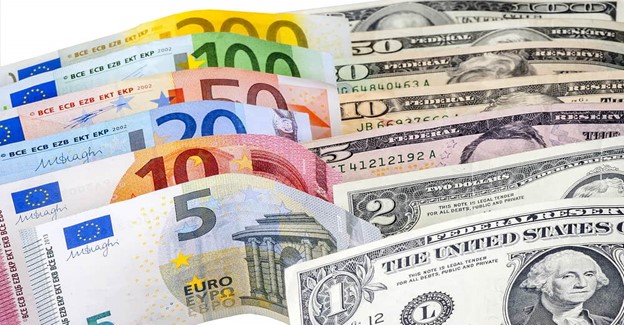
In the past 12 months, marked by an initial increase and then a stable phase in the EUR/USD exchange rate, numerous corporate treasurers have been exploring optimal methods to safeguard against currency risk. This article examines how different hedging tactics have fared over this period. For a fair evaluation, a uniform method has been used: the corporate treasurer is required to purchase 1,000,000 USD bi-monthly beginning on November 1, 2022, leading to a series of six hedging instances.
ANALYSIS
Before we start, let’s look at the history of the underlying market. The market is trading at 1.0685 after experiencing a 1.0242/1.1236 range over the period in question. The key drivers of the market have been monetary policy/yields and economic data as both regions battle inflation, energy prices, and geopolitical uncertainties.
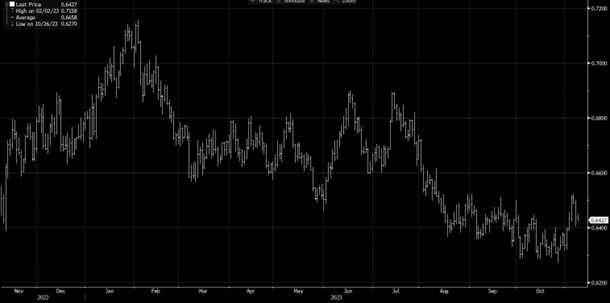
Source: Bloomberg | EUR/USD spot market over the past year.
The implied 3-month volatility is currently trading at 6.6% after experiencing a high of 10.2% and a low of 6.4%. We examine to understand how it might provide comparative advantages to different strategies through enhanced hedging rates. This current level is low and below the 5-year average of 7.6%.
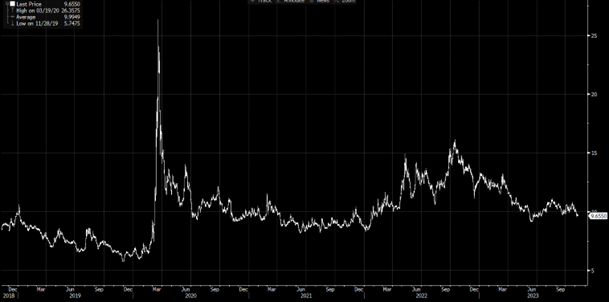
Source: Bloomberg | EUR/USD 3-month implied (traded) volatility over the past 5 years.
Strategy 1: Participating Forward
The Participating Forward gives the USD buyer / EUR seller guaranteed protection at a rate worse than the equivalent forward but, with this, gains the opportunity to outperform by benefitting from fifty percent of a favorable spot move (higher). The strategy is long volatility; therefore, lower implied volatility improves the protection level.
Outcomes
When comparing how this strategy has performed against the equivalent forward, only two out of the six outperformed. This strategy would have been better than the equivalent forward hedges by USD 1,576 or, on average, 0.03%, for our USD 1,000,000 hedges. This is a solid hedging strategy, and the lower volatility level improved the hedge rate, but it needed higher spikes for the chance to shine over this period.
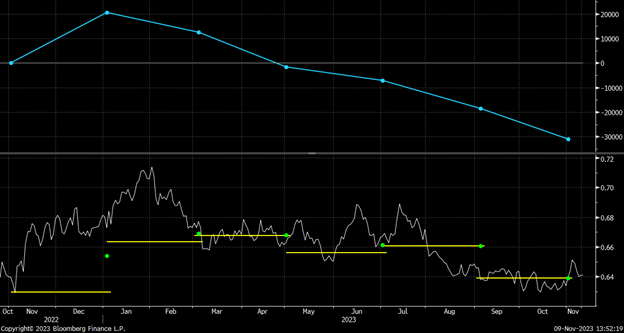
Source: Bloomberg
The chart above shows the profit or loss of hedging with a EUR/USD Participating Forward compared to equivalent forwards. The lower section of the chart shows the spot market with the protection rates in yellow and effective exchange rates in green.
Strategy 2: Forward Extra
The Forward Extra gives the USD buyer / EUR seller protection at a rate worse than the equivalent forward with the ability to benefit in a move up a predefined barrier level. If the barrier trades, then the lower protection rate is locked in. In this example, each 2-month hedge had strikes 1.5% below the spot at interception.
Outcomes
When comparing how this strategy has performed against the equivalent forward, two out of the six outperformed. Using this strategy would have a worse than the equivalent forward hedges by USD 44,944, or on average -0.75%, for our USD 1,000,000 hedges. This strategy would have excelled in markets that grind higher and would have worked for USD sellers over the last six months.
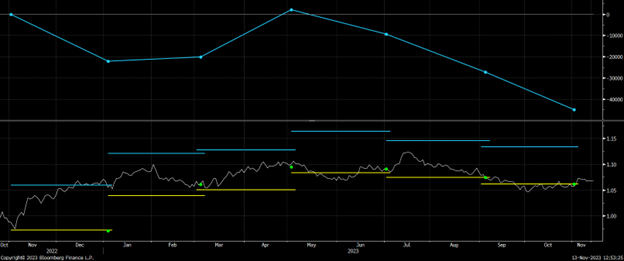
Source: Bloomberg
The chart above shows the profit or loss of hedging with an EUR/USD Forward Extra compared to an equivalent forward. The lower section of the chart shows the spot market with the strike in yellow, the barriers in blue, and effective exchange rates in green.
Strategy 3: Ratio Forward
The Ratio Forward is the reverse of the Participating Forward. It gives the USD buyer / EUR seller an improved rate compared to the equivalent forward, but if the spot moves in a favorable direction, they will be required to trade in double the amount. The strategy is short volatility; therefore, higher implied volatility improves the rate.
Outcomes
Three out of the six outperformed when comparing how this strategy has performed against the equivalent forward. Using this strategy would have been better than the equivalent forward hedges by USD 9,344 or, on average, 0.15% for our USD 1,000,000 hedges. This comparison uses a forward for the higher (leveraged) amount. This structure is short volatility, and improvements are always limited and not a significant magnitude at this current level of implied volatility.
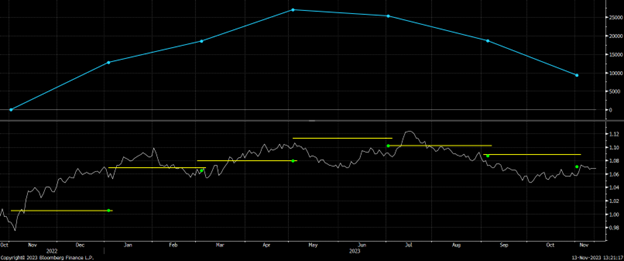
Source: Bloomberg
The chart above shows the profit or loss of hedging with an EUR/USD Ratio Forward compared to equivalent forwards. The lower section of the chart shows the spot market with the strike in yellow and effective exchange rates in green.
Strategy 4: Range Forward
The Range Forward gives the USD buyer / EUR seller protection at a rate better than the equivalent forward if the range holds. If spot trades outside the range, the protection rate moves to a level worse than the equivalent forward. The strategy is short volatility; therefore, higher implied volatility improves protection. This can be a smart way to play short volatility as it is only locally short. In this example, each 2-month hedge had ranges +/- 3.5% from the spot at interception.
Outcomes
When comparing how this strategy has performed against the equivalent forward, we can see that only three out of the six outperformed; however, this was enough overall to provide a positive result. Using this strategy would have been better than the equivalent forward hedges by USD 59,622, or on average 0.99%, for our USD 1,000,000 hedges. This approach, though not as successful as it could have been (notably in hedges 4 and 5), still proved advantageous over the equivalent forward hedges. We like to use these when the market transitions from a high-volatility environment to a range-bound one. A high implied volatility and tight range can enable great performance when this works, but the low implied level is currently against the pair.
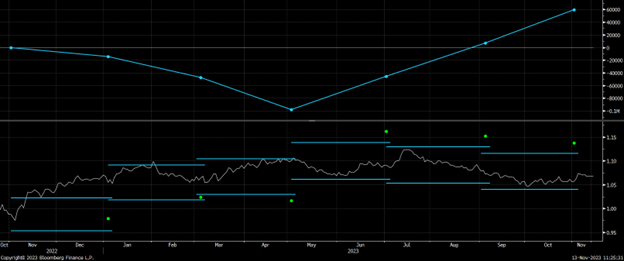
Source: Bloomberg
The chart above shows the profit or loss of hedging with an EUR/USD Range Forward compared to an equivalent forward. The lower section of the chart shows the spot market with the ranges in blue and effective exchange rates in green.
Strategy 4: Knockout Forward
The Knockout Forward gives the USD buyer / EUR seller protection at a rate better than the equivalent forward; however, this strategy knocks out if the market moves against them (spot lower). The strategy is short volatility, and lower implied volatility improves the strike level. It should be noted this strategy is not a hedge but is often used to achieve an enhanced blended exchange rate. In this example, each 2-month hedge had barriers 3% below the spot at interception.
Outcomes
When comparing how this strategy has performed against the equivalent forward, four out of the six outperformed. Using this strategy would have been better than the equivalent forward hedges by USD 24,807, or on average 0.41%, for our USD 1,000,000 hedges.
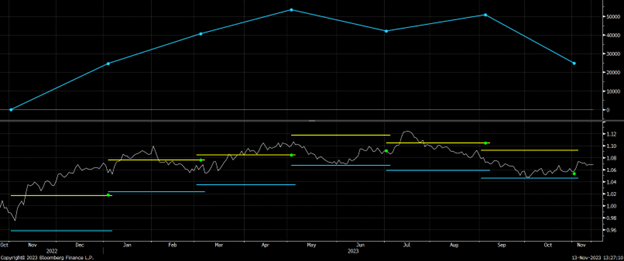
Source: Bloomberg
The chart above shows the profit or loss of hedging with an EUR/USD Knockout Forward compared to an equivalent forward. The lower section of the chart shows the spot market with the strike in yellow, the barriers in blue and effective exchange rates in green.
CONCLUSION
The results of this exercise are interesting to observe, but it is important to note that all results are in the past, and there is no guarantee of future performance. Back-testing results can also vary according to the dates and parameters used. What is important is that hedging is periodically analyzed and adjusted where necessary.
Out of the four strategies, number 4 (range forward) looks to be the most appealing on a few fronts:
- Backtesting results are favorable.
- Gives clear protection levels.
- Chance to outperform and this can be tailored.
- EUR/USD is towards the middle of the 1-year range, so levels are easier to pick.
This strategy does have some downside, namely the low implied volatility level, which reduces the improvement. For this reason, number 1 (participating forward) is also appealing as it is buying volatility.
This document is for information purposes only and does not constitute any recommendation or solicitation to any person to enter into any transaction or adopt any trading strategy, nor does it constitute any prediction of likely future movements in exchange rates or prices or any representation that any such future movements will not exceed those shown on any illustration. All exchange rates and figures appearing are for illustrative purposes only. You are advised to make your own independent judgment with respect to any matter contained herein.



